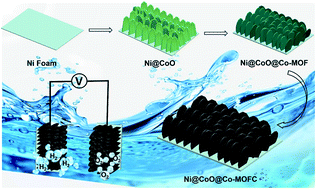Ultrathin metal–organic framework nanosheet arrays and derived self-supported electrodes for overall water splitting†
Abstract
The in situ growth of 2D metal–organic framework (MOF) nanosheet arrays on conductive substrates as self-supported electrodes is highly desirable but challenging. Herein, we demonstrate for the first time that the in situ growth of 2D Co-MOF nanosheet arrays on nickel foam can be achieved by a CoO nanowall template induced strategy ([Co(bimpy) (p-bdc) (H2O)]n, named Co-MOF, bimpy = 2,5-bis(1H-imidazol-1-yl)pyridine, p-H2bdc = p-benzene dicarboxylic acid). The subsequent pyrolysis treatment converts the 2D Co-MOF nanosheet arrays into Ni@CoO@Co-MOFC composites, which can be directly applied as a self-supported electrode for electrocatalysis. Remarkably, Ni@CoO@CoMOFC as a promising electrocatalyst exhibits an excellent electrocatalytic performance of 138 and 247 mV for the HER and OER at a current density of 10 mA cm−2, which surpasses that of most reported Co/CoO-based electrocatalysts. More importantly, a two-electrode electrolyzer fabricated from Ni@CoO@CoMOFC displays a low overpotential of 1.61 V (η10) toward overall water splitting. This study provides new insights into the development of 2D MOF nanosheet arrays and derived self-supported electrodes with high performance for overall water-splitting.



 Please wait while we load your content...
Please wait while we load your content...